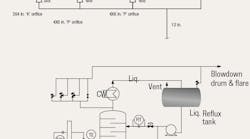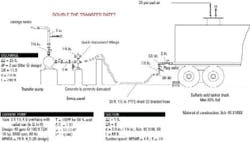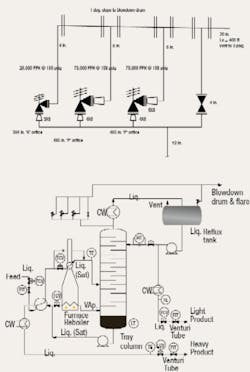February's Process Puzzler: Improve a grandfathered unloading station
Question from December's Chemical Processing
A trucking company that supplies our fuming sulfuric acid has offered us a discount in price if we can double the pumping rate of our transfer pumps (Figure 1). Management is excited about saving money but an inspection of the unloading station doesn’t inspire confidence. A new pump may be purchased but the suction line is limited because of the suction piping; spacing near the truck is very limited. The plug valves used throughout pose a significant pressure drop. Compressed air is already being used but is regulated down to 25 psig because of the danger of fatigue on the rupture discs protecting the tanker truck (35 psig is allowed by code; the setpoint for disc is 50 psig). What can be done safely to increase the transfer rate? Can we double the rate? Are there any foreseeable problems if we do increase the rate? What improvements are needed in this old, grandfathered unloading station?
Increase the NPSHA
To increase the rate of the fuming sulfuric acid unloading the following steps should be taken:
- Determine the benefits, the net amount per year that could potentially be saved by doubling the rate.
- Calculate what flow this new rate would need to be.
- Perform the hydraulics on the entire system from tanker into the storage tank — pay special attention to the suction line eliminating bottlenecks. Do the same for the pump discharge line. The problem stated that plug valves are a significant pressure loss. Look into replacing them with full port plug; you could consider full port ball valves or gate valves as they are less expensive and/or eliminate some of them if possible.
- While doing step No. 3, evaluate the existing pump first to see if it can be modified to meet the new flow requirements and head requirements of the system.
- If the pump must be replaced, what are the changes? Is a larger impeller or motor needed? Will the pump base need to be modified (obviously, the concrete needs to be repaired in the dike and the base). You need to establish the basis for design to meet the new operational requirements.
- Next, you need to determine if there are new regulatory provisions that have cropped up for this grandfathered system. Seal requirements have changed over the years. Be careful to match seals to new American Petroleum Institute (API) standards for minimizing fugitive emissions! There might be Department of Transportation (DOT) regulations that also call for certain things such as auto shutoff break-away quick connects. I'm not sure if it's required by DOT or some other agency but there are “no-drip” or dry quick connections that shut off valves in case of a break. I'm not exactly sure with trucks but I know for rail cars there is a state rail DOT inspector who shows up at our site a couple of times per year and there are DOT requirements that our rail unloading system has to meet.
- There may be some improvements in design to include. Carefully consider impeller design and other pump details.
- Consult with production and find a design that won't deliver on performance at the expense of reliability. There may be some historical records steering you away from some of the options you have considered thus far.
- Finalize your pump specifications and talk to vendors. Be wary of the quotes. Vendors like to cut the pump size and impeller trim to a minimum because of lowest price. Low clearance may contribute to corrosion in ways you can't imagine so try to duplicate conditions in the old pump, (if it was reliable) like tip speed, or such.
- Confirm your electrical system. The starter is probably okay but the wiring and conduit may have to be replaced — especially if they’ve seen service around acid. All of this could add to your project cost.
- Get quotes or estimates for any piping changes, see site maintenance, mechanical contractor or engineering. You can’t really prepare final drawings until you specify the major equipment.
- Evaluate the vent system on the tank. Is that scrubber capable of handling the increased venting rate? Are the vent lines large enough to not put too much back-pressure on the fuming sulfuric tank? Will the operating pressure still be significantly below the tank relief set pressure? You should probably do this separately from the HAZOP review required for the project. Once you have completed this relief device contingency evaluation the costs should firm up. If there are any modifications required for the tank vent system you need to define the cost.
- After collecting all this information and distilling it into a total project cost and scope you need to do a cost/ benefit analysis, e.g.., payback, rate-of-return.
If the project makes economic sense the next step will to take a closer look at the regulatory requirements. You may need to upgrade your permits. Assuming that nothing serious comes up, then you need to do a HAZOP which will probably affect your project budget and require a repeat of Step 13. Talk about trying to unload a truck a little quicker, on the surface it didn't seem that complicated.
George J Bushey, production engineer
GE Advanced Materials, Selkirk, N.Y.
Pump in a sump
Trying to please management in this situation will be very challenging. For what it’s worth here’s my two cents: put the new pump in a pit by the truck; increase the suction line size and tie the pump output to the old suction line. Replace the plug valves with ball valves if applicable to the service. Another thought is to run a second “same size” suction line parallel to the first but that wouldn't solve the bottleneck at each end. The pressure in the tank could be raised, but the differential is probably already at “critical” and the net increase in flow would be small if any at all. All of these ideas deserve a review. The final proposal won’t be elegant and will create some other problems, but the project should be considered since the concrete must be replaced anyway. There will be some concerns about the sump leaking into the ground. The process won’t be grandfathered in anymore, so no doubt there will be other improvements to be included in the price. Once all this is done, the economic incentive must be evaluated.
Bob Driskell, engineer,
WorleyParsons, Texas City, Texas
Get rid of plug valves
Interestingly, I was an operations shift supervisor in a plant that consumed significant quantities (two to four truck loads/week) of concentrated H2SO4. We had similar problems.
Since this was one of my first jobs, I got to engineer some proposed solutions. We had a shorter line but a higher height to overcome to fill our tank. Our pump transfers were slow enough interrupt necessary operator functions. The first improvement was replacing our carbon steel/stainless steel plug valves with lined full-port ball valves on the unloading line to the pump.
Our plug valves required more force to operate, were very difficult to decontaminate after replacement, and occasionally leaked. The lined ball valves offered easier operation, better corrosion resistance, and weren’t contaminated (based on inspection of the first valve tested). None after that ever had any problem.
The socket welded piping was replaced with butt-weld piping and enlarged to match the 2 in. fittings on the trucks. Pressurizing the truck for transfer was never an option. I would maintain the sizes of the fittings from the truck to the pump suction but I would eliminate non-essential elbows.
We replaced the pump with another from the same manufacturer (a left over from another area) that was compatible in materials and flange-to-flange dimensions. Typical ANSI dimensioned pumps have very similar performance curves. They even have a radial vane-type impeller version (intended for high discharge pressures and low flows). A brief inspection of the pump curve showed that the replacement pump met our needs without affecting the electrical distribution or switchgear (same bucket, heaters, starter, and wire size). We used the radial type impellers for our reactor H2SO4 injection, very high pressure (relatively) and low flow. Careful selection of the pump and impeller should reduce NPSHR. As for the political situation, i.e., regulatory agencies, insurance companies, etc., we did not have any serious problems. However, that was many years ago.
We made improvements when we could. A PHA review on an anhydrous ammonia system recommended a requirement for transfer safety valves; these valves cut-off flow if a line ruptures. We appreciated the same potential for our other truck unloading stations and used it there. These transfer valves are closed without the need for an operator by a cable, directly or along the hose, clipped to the truck. A remote pull, or actuation is also usable. If they already connect and disconnect hoses for transfers, this device is just another valve, spatially speaking.
I cannot fathom any reason I would want to increase the charge pressure to the tanker-truck. There are too many unnecessary scenarios that result in potential injury for me to entertain that possibility.
Tim H. Gilder, production superintendent - VCM
Shintech, Plaquemine, La.
Raise the pad pressure
I believe the PCV set point can be increased up to 30 PSI, without any problems with the regulatory agencies. If required, a quick opening valve or PSV can be provided downstream of PCV in place of the rupture disc. A review will be necessary with the site safety manager and, perhaps, the trucking company safety manager. A PHA would certainly be necessary with an exploration into documentation of just why the set pressure was reduced. A fight over a pressure increase is probably worth it (raising the pressure will it contribute significantly to NPSHA); a typical PHA will take a week of meetings and preparations. The outcome may not be as expected — it may increase the price tag of your project.
The plug valves can be replaced with full bore ball valves, if this allows a larger pump and higher NPSHR. One concern I have is the material of construction of the new pipe; carbon steel is limited to 1 meter per second (m/s). Carbon steel is less expensive than stainless steel. Above 1 m/s, the iron sulfide layer protecting the pipe will be eroded.
Kamal Parikh, general manager of technical services
Reliance Industries Ltd., Surat, India
Split the flow
To increase the flow through the system, I would consider the following:
- Twin the suction pipe to reduce the head loss in this section;
- Although it will probably have a minimum effect, decrease the backpressure in the receiving tank;
- Install a new pump that will meet the new process conditions; and
- Increase the line size where possible to reduce the pressure drop.
Running a second suction line may make it easier to snake the pipe through the existing space. Another option might be to consider two pumps — in parallel; this could be difficult to control and lead to a few operations issues. Decreasing the backpressure will have a minimal effect because fans typically run at the 1.5-2 psig range. Increasing the fan draw will increase wastewater generation slightly unless the extra acid captured by the scrubber is recycled in the process.
Jim Darby, process design engineer
LANXESS Inc., Sarnia, Ontario
Avoid carbon steel
This isn’t a solution to your pumping problem, but more of a caution, be careful when increasing the velocity of sulfuric acid through piping. If carbon steel pipe is being used for the transfer of the sulfuric acid, the velocity of the sulfuric acid in the pipe must be kept low or it can cause corrosion problems. In carbon steel piping the sulfuric acid forms a sulfate layer on the pipe. This acts as a corrosion barrier in the pipe. At higher velocity, this barrier gets washed off and then it just keeps trying to reform again and again, corroding away the pipe. This corrosion can be very rapid and is especially apparent in elbows and other changes in direction. For your pumping problem, can the pump be lowered any (excavate and areas to mount the pump in) to provide more room and more NPSH for a higher capacity pump?
Bob Welsh, reliability engineer
Arkema, Inc., Carrollton, Ky.
April's Puzzler
During a routine walkthrough at a new job we found a problem with how the relief valves are laid out for a distillation column (Figure 2). After further thought, we wondered if the piping is undersized. A review of the relief scenario and a mechanical sketch of the piping reveal some background. The relief valves are sized for a total flow of 170,000 lb/hr for fire and other scenarios; fire isn’t the worst. All valves are conventional, not pilot valves or balanced bellows. Sizing was performed for a mixture in the column of 64% ethanol and 36% ethyl acetate. The relief conditions were: 150 psig and 149ºC. There are other problems with the set-up, which need to go to the maintenance manager right away. What should go in the report? What must be done to improve the safety of the relief system?
Send us your comments, suggestions or solutions for this question by March 16, 2007. We’ll include as many of them as possible in the April 2007 issue and all on CP.com. Send visuals — a sketch is fine. E-mail us at [email protected] or mail to ProcessPuzzler, Chemical Processing, 555 W. Pierce Rd., Suite 301, Itasca, IL 60143. Fax: (630) 467-1120. Please include your name, title, location and company affiliation in the response.
And, of course, if you have a process problem you’d like to pose to our readers, send it along and we’ll be pleased to consider it for publication.




